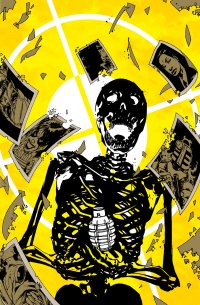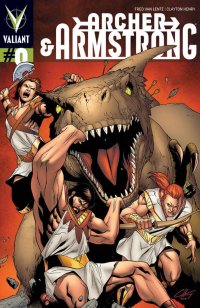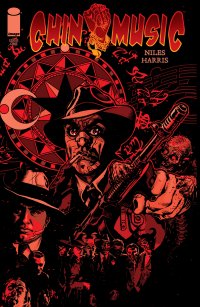Suicide Squad #20 (DC Comics, $2.99)
By Devon Sanders (@devonsanders)
Somewhere between the brutal baton beating and the robot prostitute I realized that Suicide Squad #20 just wasn’t for me…
I want to like this book, it has Harley Quinn in it after all. And Deadshot… only strapped to a table and muttering stuff to himself. This comic has the latest iteration of The Unknown Soldier in it and he’s a bad ass because… well… baton. Suicide Squad also has a fit and toned woman in it going by the name of Amanda Waller. She’s not as much of a force of nature as the Amanda I once knew. Her main function now seems to be standing around assessing contrived scenarios in an effort to create even more internal conflict. It has a twist ending and a surprising addition to the cast that’s… interesting. It will make people talk. And that pretty much was this issue’s reason for being; conflict and the hope that you’ll talk about it. When you really think about it, isn’t that what DC’s New 52 is all about? I couldn’t tell you what the next issue’s mission will be or this comic’s overall mission statement because new writer Ales Kot never quite reveals it. There’s just a lot of bad asses doing the thing many bad asses would do, I guess.
Artist Patrick Zircher illustrates it all reliably, keeping the reader’s eye occupied. All of that to say, “The art was good.”
Oh, don’t get me wrong, I can see why a lot of folks would like this book. It has what you’d expect from a New 52 comic; it has conflict a’plenty. There’s indecision, posturing, cynicism and betrayal all over the place. I didn’t dislike Suicide Squad #20; it just wasn’t what I’m looking for in a comic these days. It’s very much a New 52 comic.
Rating: 




Out of a Possible 5 Stars
 Archer & Armstrong #0 ($3.99, Valiant)
Archer & Armstrong #0 ($3.99, Valiant)
by D.S. Randlett (@dsrandlett)
I’d like to think that there’s a secret Simpsons-style instruction pamphlet or film circulating among comics professionals called something like “So You’re Thinking About Making a New Reader-Friendly Standalone Issue In An Ongoing Series.” I have no idea what Troy McClure would tell the writers and artists of the field, as the standalone issue is a weird thing. Most stories, but especially serialized action stories, rely on movement and momentum. After all, a plot twist can’t twist without the feeling of going in one direction, only to be forced to pivot in a new direction. Hell, we typically describe our emotional lives in terms of physical movement. We fall and rise into ourselves daily. If stories are the reflections of different aspects of internal life, then to feel authentic stories must mirror the swinging, swaying, and loping of our emotions. The standalone issue tends to be the equivalent of a subway station, a place where new people can get on board, But for that to happen, the train has to stop.
Creators in the field rarely pull this off, especially if they’re playing a long game with their series. Archer & Armstrong is one such series, and a quite good one at that. To continue the subway analogy, if you’re running behind on getting somewhere, stopping to pick up new people can be really annoying. Over its year-long run, this series has kept up its sense of momentum through deft plotting and characters that feel, if not real, at the very least complete. Of the two title characters, the one that has the most claim to the title of “protagonist” is Obadiah Archer, as the series is very much about what it’s like to be young today. With tongue firmly planted in cheek, the young Archer, raised in a very amped up version of American elite culture, teams up with the immortal Aram Anni Padda (who goes by Armstrong these days). Armstrong, as far as I can tell, is a stand in for a sort of Epicurean-Humanist sensibility that rears its head across all epochs, but is ultimately suppressed by the powerful interests of the day. Come to think of it, he looks kind of like Ai Wei Wei.
In spite of the momentum built around the continuing tutelage of the lost Archer by the humanist Armstrong, this is a stop that works for the series. It helps when one of your protagonists is an immortal who’s been around since the dawn of civilization and has his own stories to explore. Here, writer Fred Van Lente takes the opportunity to give his characters a bit of a breather, while defining the Armstrong character. There’s always been a pathos to the character, but here we see the story of that pathos fleshed out in a compelling way. It’s also a good bit of pulpy fun. Here we have the Anni Padda brothers in the ancient world, encountering feathered dinosaurs ridden by bizarre scorpion-men in a Garden of Eden made of jewels. The dynamic between the brothers is also a lot of fun, feeling very much like the classic Fantastic Four dynamic. But at its center, its the story of what sets the stage for the fracturing relationship between the brothers, which fits in with the series’ M.O. of fun with a bit of feeling.
The art is also very strong here. Sometimes it can look a bit rushed in this series, but regular artist Clayton Henry does a solid job here. There aren’t really any feats of storytelling daring-do, but what is there gets the job done. Where Henry really excels in this issue is his sense of depth here. There are some great renderings of the young Armstrong before his gut came into play that really sell the sense the man’s sheer size. The ancient palaces and ruins feel suitably huge and mythic, and Henry is quite deft at capturing the writing‘s humor.
This is a zero issue that’s worth the stop, and even if you haven’t already checked out the series yet, worth getting on.
Rating: 




Out of a Possible 5 Stars
Chin Music #1 (Image, $2.99)
By Jeb D.
We’re in a darkened office of the sort we associate with a Depression-era detective. A man sits at a desk, wearing a fedora; a shoulder holster is visible over his shirt. For five meticulously-illustrated pages, we see him carving some kind of mystic runes into a bullet, and testing the result; artist Tony Harris makes this small, quiet action feel as intense as an all-out gunfight. Harris, and writer Steve Niles, here serve not only as director and cinematographer, but as Foley artist as well: the huge Kirby-esque “SCRITCH!” and “KLIK-CHAK!” sound effects heighten the room’s disquieting silence.
Jump cut to Egypt, of what seems to be the same period (we’ll get more specific placement when Niles reveals the identity of the bullet-carver). A scruffy looking fortune teller has run afoul of some powerful forces, and their methods of dealing with it horrifies not only the reader, but our bullet-carving friend, in whose path the unfortunate seer lands, half a world away. Their bizarre, frightening encounter makes it amply clear that Niles and Harris, while borrowing from 20th century history, aren’t going to be restricted by it.
The issue concludes with what looks like a riff on a familiar movie scene, with a stout, expensively-suited gangster addressing his minions around a table, telling them that it’s time that an interfering cop was dealt with… but with a startlingly unexpected and gruesome result.
It’s hardly a spoiler to say that Chin Music is going to fuse hard-boiled noir with sanguinary horror–if the cover, stuffed with imagery of mobsters, monsters, and mystic symbols wasn’t enough… well, this is Steve Niles, after all. But his construction of this fiercely different alternate history is sufficiently ingenious that it only seems fair to let readers mine its secrets for themselves.
Besides the crisp storytelling, Harris’s art deftly handles the shifts in tone as we move from the darkened office to the heat-blasted desert to the elegance of a Chicago hotel. He’s working in a darker, more fluid style than fans of Starman or Ex Machina might expect, a tribute to his versatility. If there’s as much blood to follow as we’ve seen so far (and I have no reason to doubt that), no one’s looking forward to that prospect more than Harris himself: he seems to be having a grand, ghoulish time of it already.
Rating: 




Out of a Possible 5 Stars